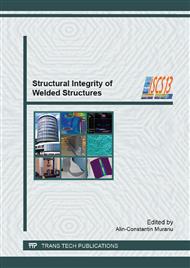p.33
p.41
p.49
p.54
p.60
p.68
p.76
p.82
p.87
Technological Characteristics of a Dual-Phase Steel with 0.09% C and 1.90% Mn Obtained by Intercritical Quenching
Abstract:
With this article, the authors present a number of technological characteristics determined for a dual-phase steel with 0.09% C and 1.90% Mn. This steel was obtained through intercritical quenching: heating at 740, 780 and 820 °C, maintaining for 30 minutes and then cooling in water, oil, oil in magnetic field of direct current (DC) and oil in ultrasonic field. It was determined the degree of cold upsetting, the ultimate tensile strength of the resistance butt welded joints and the cutting property based on the study of cutting forces and surface roughness; it was analyzed the influence of heat treatment parameters (heating temperature, quenching medium) and ferrite-martensite structure on these characteristics.
Info:
Periodical:
Pages:
60-67
Citation:
Online since:
September 2013
Authors:
Price:
Сopyright:
© 2013 Trans Tech Publications Ltd. All Rights Reserved
Share:
Citation:


